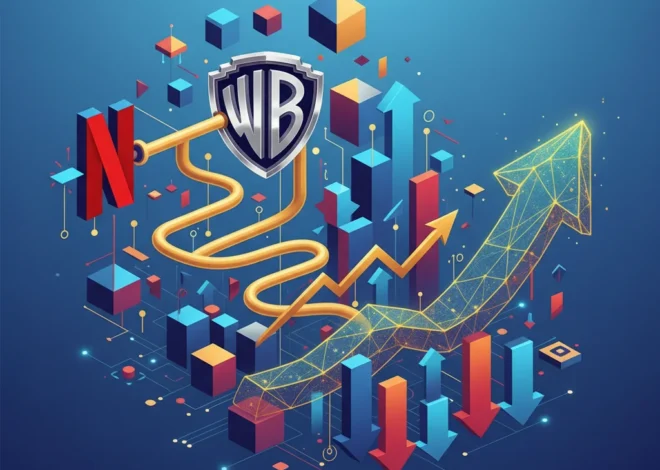
Beyond the Hype: Where to Find Real Value in a World Obsessed with Private Credit
In the modern world of finance and investing, it’s easy to get swept up in the prevailing current. For the past few years, that current has been flowing powerfully towards one destination: private credit. It’s the asset class on every institutional investor’s lips, promising high yields in a volatile market. But a singular focus on any one trend, no matter how popular, can lead to missed opportunities and unforeseen risks. The most astute investors know that true value is often found by looking where others aren’t.
While the financial world debates the finer points of direct lending returns, seismic shifts are happening in other, equally critical sectors. A legendary Hollywood empire is teetering on the brink of a sale, potentially reshaping the entire media landscape. Simultaneously, a new space race is heating up across the Atlantic, as European challengers rise to break the dominance of a single American behemoth. These stories, seemingly disconnected, are woven together by a common thread: they represent significant, under-the-radar developments that will define the next phase of the global economy.
This analysis will take you beyond the headlines, exploring the nuanced reality of private credit, the high-stakes drama unfolding at Warner Bros. Discovery, and the geopolitical battle for the final frontier. For investors, business leaders, and anyone interested in the future of the stock market, understanding these undercurrents is not just an advantage—it’s essential.
The Private Credit Paradox: Looking Beyond the Allure of Yield
Private credit has exploded in popularity, becoming the darling of the alternative investment world. At its core, it involves non-bank institutions lending money directly to companies, often those considered too risky or complex for traditional banking channels. The appeal is obvious: higher interest rates and returns that appear disconnected from the volatility of public markets. It seems like the perfect solution in an uncertain economic climate.
However, a growing number of experts are urging caution. The relentless flood of capital into the space means more competition for deals, which can compress returns and encourage riskier lending practices. As one Unigestion partner noted, while private credit can offer equity-like returns, investors may be “better off just buying equities” for a similar risk profile. The conversation is shifting from a simple focus on yield to a more sophisticated analysis of risk-adjusted returns, liquidity, and the underlying quality of the debt.
To truly understand the trade-offs, it’s helpful to compare the asset class directly with more traditional investments.
A Comparative Look: Private Credit vs. Public Markets
| Feature | Private Credit | Public Markets (Bonds/Equities) |
|---|---|---|
| Liquidity | Low; capital is often locked up for years | High; assets can be bought and sold easily |
| Transparency | Opaque; deals are private with limited public data | High; extensive public reporting and regulatory oversight |
| Potential Returns | High, often with floating rates beneficial in rising rate environments | Variable, subject to market volatility |
| Risk Profile | Credit risk (borrower default), illiquidity risk, manager selection risk | Market risk, interest rate risk, inflation risk |
| Investor Access | Typically limited to institutional and accredited investors | Open to all investors |
The key takeaway is that private credit is not a magic bullet. It is a complex tool that requires deep expertise to wield effectively. The real story isn’t the headline return; it’s the skill of the fund manager, the quality of the due diligence, and the structure of the deals. For investors, the question should not be “Should I be in private credit?” but rather “What role should it play in a diversified portfolio, and am I being adequately compensated for the risks I’m taking?”
Media M&A: David Ellison’s Audacious Play for a Hollywood Crown Jewel
While institutional investors scrutinize debt covenants, a drama of a different kind is unfolding in Hollywood. Warner Bros. Discovery (WBD), a titan of media forged from the massive merger of WarnerMedia and Discovery, Inc., is in trouble. Under CEO David Zaslav, the company has pursued a brutal, debt-focused strategy of cost-cutting and content write-offs, which has alienated creative talent and failed to impress Wall Street. The company is saddled with a staggering debt load, reported to be around $40 billion, and its stock has plummeted.
Into this turmoil steps David Ellison, son of Oracle founder Larry Ellison and the visionary behind Skydance Media. Skydance, the studio behind hits like Top Gun: Maverick, has reportedly made a preliminary offer to acquire National Amusements, the holding company that controls Paramount Global, with a subsequent plan to merge it with WBD. This isn’t just a business transaction; it’s a bold, strategic move to consolidate some of the most iconic assets in entertainment history—from HBO and the Warner Bros. film studio to CBS and the Paramount movie lot.
The logic is compelling. A combined entity could achieve massive scale, create significant cost synergies, and boast a content library unrivaled in the industry. Ellison’s move effectively forces WBD’s board to confront a critical question: is the current strategy working, or is it time to consider a sale? This development puts immense pressure on Zaslav and a board that has, until now, seemed committed to a go-it-alone approach. The potential for such a mega-merger sends ripples across the entire media and financial technology landscape, as it would redefine the streaming wars and the valuation of content itself.
The Billion-Dollar Standoff: Inside Venture Global's High-Stakes Clash with its Biggest LNG Clients
The New Space Race: Europe’s Urgent Quest to Dethrone SpaceX
Further from the glamour of Hollywood, another high-stakes battle is underway—this one for the heavens. For years, Elon Musk’s SpaceX has achieved a near-monopoly on the commercial satellite launch market. Its reusable rockets have dramatically lowered the cost of accessing space, making it the default choice for companies and governments around the world, including in Europe. This dominance, however, has created a significant strategic vulnerability for the continent.
Relying on a single, foreign provider for critical infrastructure like satellite deployment is a massive geopolitical risk. Recognizing this, Europe is finally fighting back. A new wave of private rocket companies, backed by both venture capital and government support, is emerging to create a homegrown launch capability. Companies like Germany’s Isar Aerospace and Rocket Factory Augsburg are at the forefront of this movement, developing smaller, more agile rockets designed to compete with SpaceX on cost and flexibility. The European Space Agency and the European Commission are actively supporting these efforts, understanding that sovereign access to space is a matter of economic security and defense.
This isn’t just about building rockets; it’s about fostering an entire ecosystem. It involves advancements in manufacturing, materials science, and the kind of innovative financial technology models needed to fund these capital-intensive ventures. The competition is fierce, but the goal is clear: to break Europe’s dependency and ensure it has a seat at the table in the rapidly growing space economy. According to the FT, European officials now see this as an urgent priority, with one German politician calling the reliance on SpaceX “a huge problem” (source).
Key Players in the European Launch Market
| Company | Country | Key Vehicle | Strategic Focus |
|---|---|---|---|
| Isar Aerospace | Germany | Spectrum | Small-to-medium satellite constellations |
| Rocket Factory Augsburg (RFA) | Germany | RFA One | Low-cost, high-frequency launches |
| Arianespace | France (Pan-European) | Ariane 6 / Vega-C | Incumbent provider for heavy-lift and institutional missions |
| PLD Space | Spain | Miura 5 | Reusable microlaunchers |
Conclusion: The Art of Seeing the Bigger Picture
The financial markets are complex, dynamic systems. While it’s tempting to follow the herd into popular trades like private credit, enduring success in investing and business strategy comes from a wider perspective. The cautious re-evaluation of private credit, the potential tectonic shift in the media industry, and the brewing competition in the space sector are not isolated events. They are powerful indicators of a global economy in transition.
They teach us that behind every headline return, there is a nuanced risk profile. They show that even the most entrenched legacy companies are vulnerable to disruption and bold strategic plays. And they remind us that technological dominance in one era can ignite a fierce competitive response in the next. For those willing to look beyond the hype, the opportunities to understand, anticipate, and capitalize on these shifts are immense. The most valuable returns are often found not in the crowded center of the market, but at its dynamic and evolving edges.
China's Singles Day Kicks Off Early: A Strategic Lifeline for a Faltering Economy?


